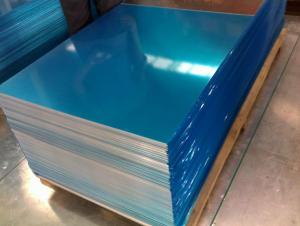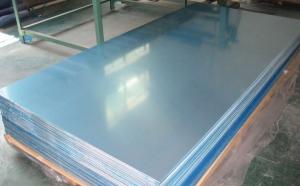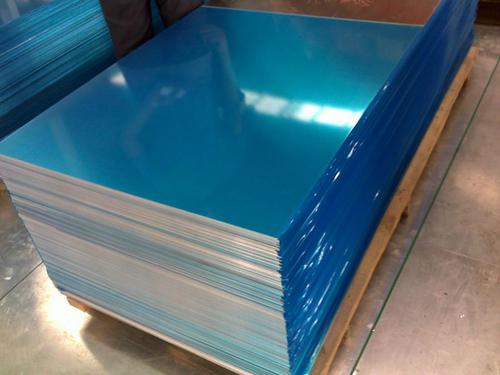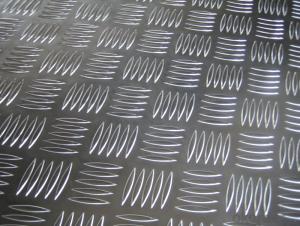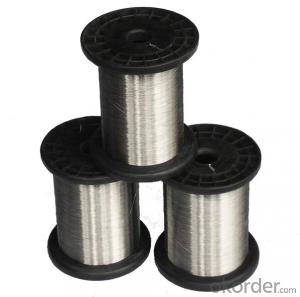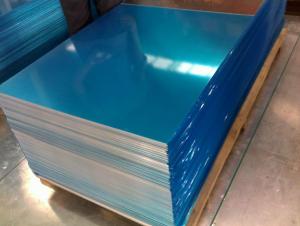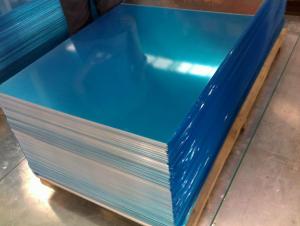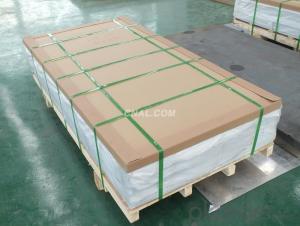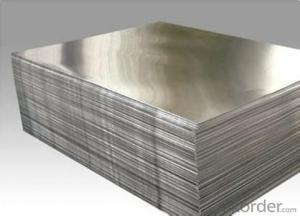Cargo Trailer Aluminum Sheets 8xxx Mill Finished
- Loading Port:
- China Main Port
- Payment Terms:
- TT or LC
- Min Order Qty:
- 8 m.t.
- Supply Capability:
- 10000 tons m.t./month
OKorder Service Pledge
OKorder Financial Service
You Might Also Like
1.Structure of Aluminum Sheets 8xxx Mill Finished Description:
Aluminum sheets 8xxx mill finished is cut from aluminum coils 8xxx. Aluminum sheets 8xxx mill finished have great ductility, heat conductivity, anti-corrosion and moisture resistance properties.
Aluminum sheets 8xxx mill finished is widely used for electronics, instruments, lighting decoration, packing industry, house decoration, curtain wall, honeycomb-core panel, sandwich panel, aluminum composite panel and aluminum composite pipes.
2.Main Features of the Aluminum Sheets 8xxx Mill Finished:
• Superior quality of raw material
• Reasonable and stable chemical composition
• Accurate tolerance
• Goode mechanical property
3.Aluminum Sheets 8xxx Mill Finished Images

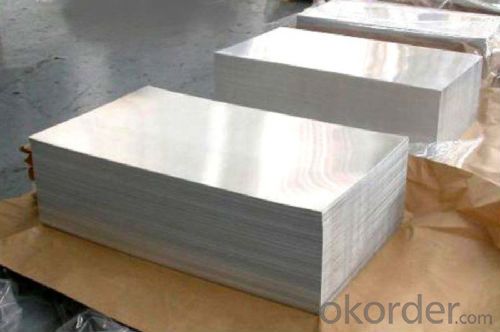
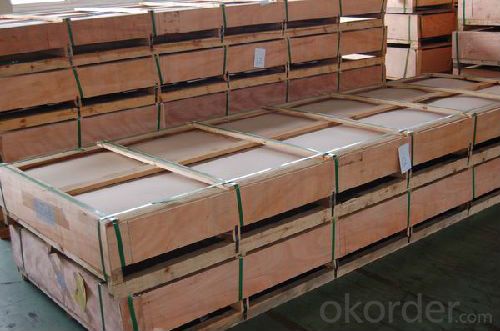
4.Aluminum Sheets 8xxx Mill Finished Specification
| Alloy | AA8xxx (AA8011, AA8006 etc) |
| Temper | H14,H16,H18,H22,H24,H26,H32,O/F |
| Thickness | 0.2mm--100mm |
| Width | 30mm--1700mm |
| Standard | GB/T 3880-2006 |
5. FAQ of Aluminum Sheets 8xxx Mill Finished
A.How to guarantee the quality?
Customers are welcome to our mill to visit and check the products. Besides, we can arrange a third party to test the aluminum sheets 8xxx mill finished products.
B. What is the MOQ?
The MOQ of aluminum sheets 8xxx mill finished is 7-8 tons for each size.
- Q: What can I do to remove the paint from the painted aluminum sheet?
- The aluminum need scraping, the car is not easy to enamel paint.Is the aluminum plate with a thickness of more than 0.2mm to 500mm, 200mm width, length less than 16m aluminum material called aluminum plate or aluminum sheet, aluminum is below 0.2mm, 200mm within the width of the row material or bar (of course, with the progress of the large equipment, the width can be 600mm row material also more). Aluminum sheet refers to the rectangular plate made of aluminium ingot rolled and divided into pure aluminum plate, alloy aluminum plate, thin aluminum plate, middle thick aluminum plate and pattern aluminum plate.
- Q: What are the standard sizes of aluminum sheets?
- The standard sizes of aluminum sheets vary, but some common dimensions include 4 feet by 8 feet, 4 feet by 10 feet, and 5 feet by 10 feet.
- Q: Are aluminum sheets suitable for chemical storage applications?
- Indeed, aluminum sheets prove to be appropriate for chemical storage applications. Renowned for its remarkable resistance to corrosion, aluminum emerges as an ideal choice for the storage of various chemicals. Its surface develops a naturally occurring oxide layer, which serves as a safeguarding barrier against moisture and chemicals. Furthermore, the lightweight and manageable nature of aluminum sheets render them convenient for storage objectives. Nevertheless, it remains crucial to contemplate the nature of the chemical in question and seek advice from specialists to guarantee compatibility with aluminum. Certain highly corrosive or reactive chemicals might necessitate alternative materials for storage.
- Q: What are the standards and certifications available for aluminum sheets?
- There are several standards and certifications available for aluminum sheets, including the American Society for Testing and Materials (ASTM) standards, the Aluminum Association standards, and the ISO 9001 certification. These standards and certifications ensure the quality, durability, and performance of aluminum sheets, and help customers make informed decisions while selecting the appropriate product for their specific applications.
- Q: Can aluminum sheets be easily shaped or bent?
- Yes, aluminum sheets can be easily shaped or bent. Aluminum is known for its excellent malleability and ductility, which allows it to be easily formed into various shapes and bends. It can be manipulated using a variety of techniques such as rolling, pressing, or even using hand tools. The malleability of aluminum makes it a preferred choice in industries such as automotive, aerospace, and construction, where it is commonly used in the production of parts and structures that require complex shapes and bends. Additionally, aluminum's lightweight and corrosion-resistant properties further contribute to its suitability for shaping and bending processes.
- Q: Are aluminum sheets suitable for medical equipment?
- Yes, aluminum sheets are suitable for medical equipment. Aluminum is a lightweight metal that offers excellent durability and corrosion resistance, making it a popular choice for medical equipment manufacturing. It is used in various medical devices such as surgical instruments, diagnostic equipment, and patient monitoring systems. Aluminum sheets are easy to shape and form, allowing for the fabrication of intricate medical equipment designs. Additionally, aluminum is non-toxic and non-magnetic, which are important properties in medical settings. Its ability to withstand sterilization processes such as autoclaving further enhances its suitability for medical equipment. Overall, aluminum sheets are a reliable and versatile material for the production of medical equipment.
- Q: Can the aluminum sheets be painted or coated with a different color?
- Indeed, it is possible to paint or coat aluminum sheets with a different color. Aluminum, being a flexible material, lends itself well to the application of paint or coating in order to achieve the desired color or finish. This can be accomplished using a range of techniques, including powder coating, anodizing, or the use of liquid paint. These methods serve to both protect the aluminum sheet's surface and alter its color or appearance. The selection of the specific paint or coating will hinge upon the particular requirements and desired outcome. On the whole, the practice of painting or coating aluminum sheets is commonplace, granting opportunities for customization and aesthetic enhancement.
- Q: Can the aluminum sheets be used for manufacturing aircraft landing gears?
- Indeed, the utilization of aluminum sheets is viable for the production of aircraft landing gears. Aluminum stands as a widely chosen substance within the aerospace field due to its beneficial attributes, namely its lightweight yet robust composition, exceptional resistance against corrosion, and commendable fatigue performance. These characteristics render aluminum sheets apt for the manufacturing of diverse aircraft components, including landing gears. The integration of aluminum into landing gears plays a pivotal role in diminishing the overall weight of the aircraft, a crucial aspect for optimizing fuel efficiency and overall performance. Moreover, aluminum boasts the capability to be effortlessly shaped, welded, and machined, thereby facilitating the creation of intricate forms and designs indispensable for landing gears.
- Q: Can aluminum sheets be used in construction?
- Yes, aluminum sheets can be used in construction. They are commonly used for roofing, siding, and structural applications due to their lightweight, corrosion-resistant, and durable properties.
- Q: What are the different methods for cutting aluminum sheets?
- There are several methods commonly used for cutting aluminum sheets. 1. Shearing: This method involves using a sharp blade to make a straight cut through the aluminum sheet. Shearing is typically used for thinner sheets and produces clean, straight cuts. 2. Sawing: Sawing is another method used to cut aluminum sheets. It involves using a saw blade with small teeth to cut through the material. Sawing can be done manually or with the help of power tools such as band saws or circular saws. 3. CNC Machining: Computer Numerical Control (CNC) machining is a highly precise method for cutting aluminum sheets. It involves the use of a computer-controlled machine that follows programmed instructions to cut the sheet into the desired shape. CNC machines can create complex cuts and shapes with high accuracy. 4. Laser Cutting: Laser cutting is a non-contact method that uses a high-powered laser to cut through aluminum sheets. The laser beam melts or vaporizes the aluminum, creating a clean and precise cut. Laser cutting is commonly used for intricate designs and can be done with a high level of precision. 5. Waterjet Cutting: Waterjet cutting uses a high-pressure jet of water mixed with an abrasive material to cut through aluminum sheets. This method is versatile and can be used for a wide range of materials and thicknesses. Waterjet cutting produces clean cuts without generating heat, making it suitable for heat-sensitive materials. 6. Plasma Cutting: Plasma cutting involves the use of a high-temperature plasma arc to cut through aluminum sheets. The plasma arc melts the metal and blows away the molten material, creating a cut. Plasma cutting is commonly used for thicker aluminum sheets and can be done manually or with the help of CNC machines. These methods offer different levels of precision, speed, and suitability for different sheet thicknesses and designs. The choice of cutting method depends on factors such as the desired cut quality, the thickness of the aluminum sheet, and the specific requirements of the project.
Send your message to us
Cargo Trailer Aluminum Sheets 8xxx Mill Finished
- Loading Port:
- China Main Port
- Payment Terms:
- TT or LC
- Min Order Qty:
- 8 m.t.
- Supply Capability:
- 10000 tons m.t./month
OKorder Service Pledge
OKorder Financial Service
Similar products
Hot products
Hot Searches
Related keywords
